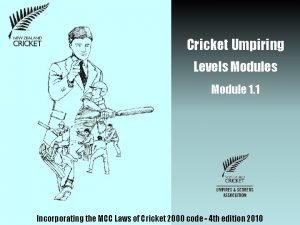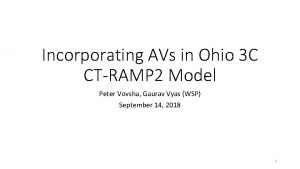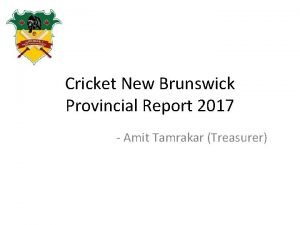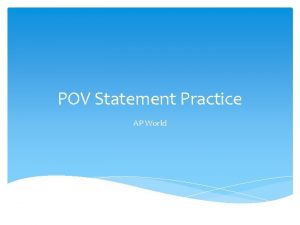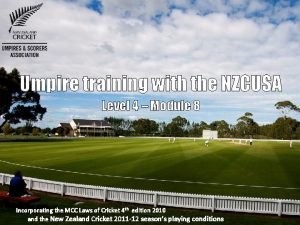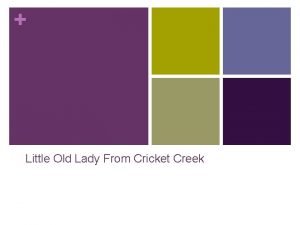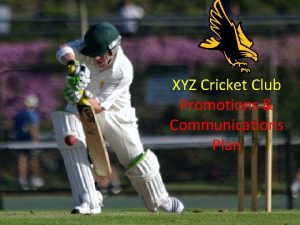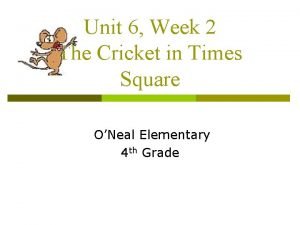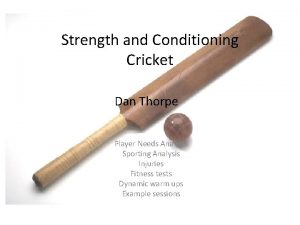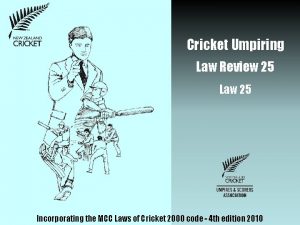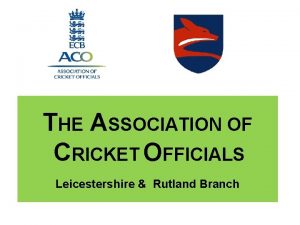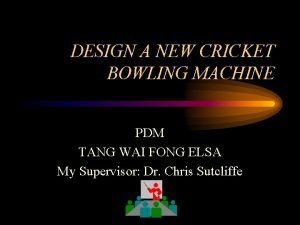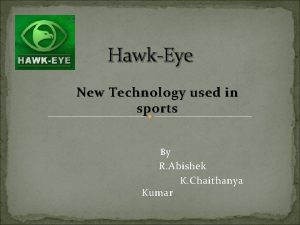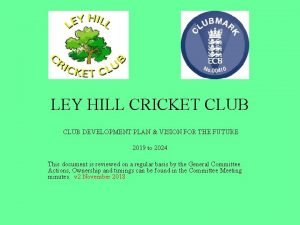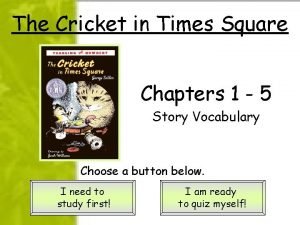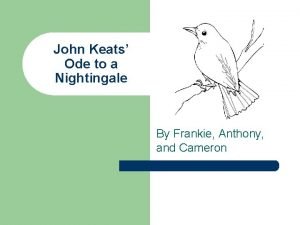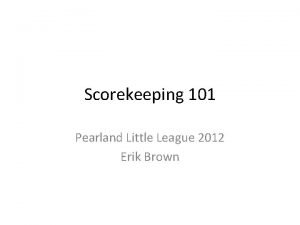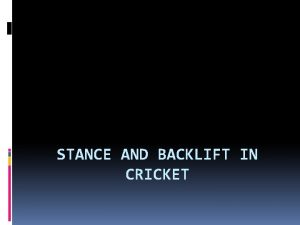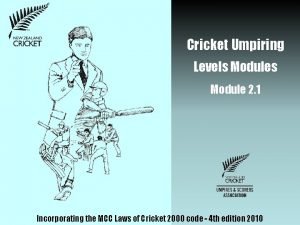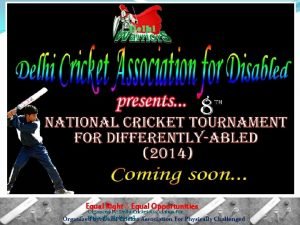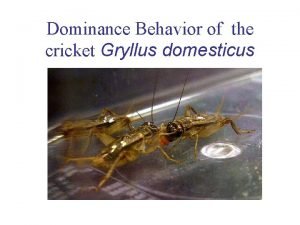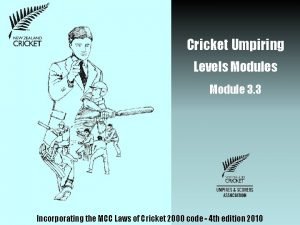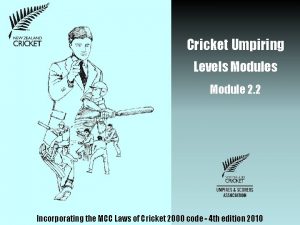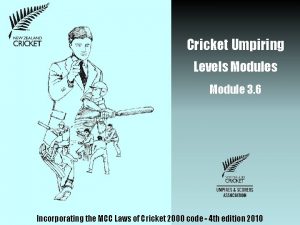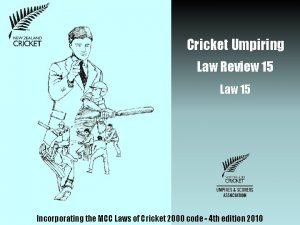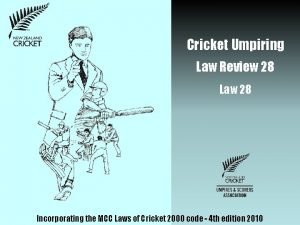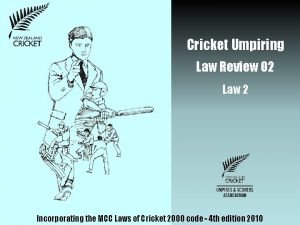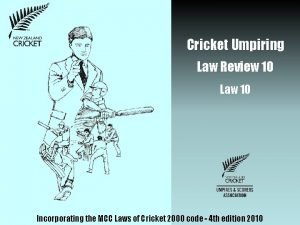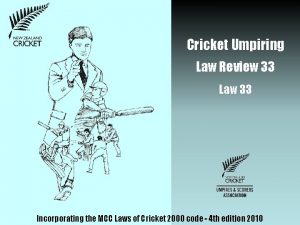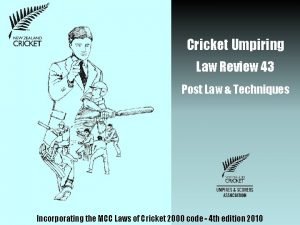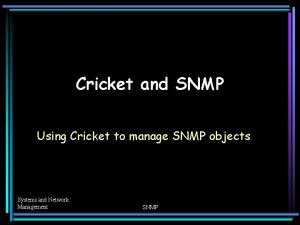Cricket Umpiring Levels Module 1 2 1 Incorporating










































- Slides: 42

Cricket Umpiring Levels Module 1. 2 1 Incorporating the MCC Laws of Cricket 2000 code - 4 th edition 2010

Extras There are two forms of Bowling extras NO-BALL & WIDEs WIDE Either umpire can call & signal NO-BALL for an offence within his jurisdiction Only the bowler’s end umpire can call & signal WIDE This call & signal is made after the ball passes the striker however, the ball is deemed WIDE from the moment it leave the bowler’s hand There are three forms of Fielding extras Byes, Leg-byes & Penalty runs The appropriate umpire signals the scorers when the ball is dead

Bowler’s foot-faults For the bowler’s feet to be fair … The back foot … must not touch or be outside the Return crease Some part of the front foot … grounded or raised, must be behind the Popping crease If not the bowler’s end umpire must call & signal NO-BALL

Bowler’s foot-faults Fair - this meets both criteria

Bowler’s foot-faults Fair - this meets both criteria

Bowler’s foot-faults Fair - this meets both criteria The front foot is behind the Popping crease Fair - this meets both criteria Part of the front foot is behind the Popping crease

Bowler’s foot-faults Un-fair The back foot is touching the Return crease NO-BALL Un-fair The back foot is outside the Return crease NO-BALL

Bowler’s foot-faults Un-fair The front foot is in-front of the Popping crease NO-BALL Un-fair The front foot is landed on the opposite side of the imaginary center-line through the pitch NO-BALL

Defining a WIDE A tall batsman can reach further than a short batsman This it is important when considering calling & signalling WIDE 9

The ball must be within his reach - for him to hit it with his bat - with a normal cricket stroke - from where he is standing, in a normal guard position If the ball is within his reach and he fails to hit it and runs are scored 10 those runs must be signalled as Byes

Making it easier to define a WIDE NZC recommends additional white lines be painted - between the Popping crease and the Bowling crease – painted 89 cm from the imaginary centre-line to assist when deciding off-side Wides 11 If the ball travels past the striker on the leg-side it may be called & signalled WIDE

A high WIDE If the ball passes CLEARLY above head-height of the striker - when standing upright - the bowler’s end umpire must call & signal WIDE It is an unfair delivery 12

Fielding extras Byes are signalled - when the ball passes the striker and runs are scored - that ball not being a Wide The ball is missed by the keeper and by other fielders permitting runs to be completed or a Boundary 4 Byes are Fielding extras That ball is a ball of the over 13

Fielding extras Leg-byes are signalled - when the ball is deflected off the striker and not his bat - and runs are scored The ball is missed by the keeper and by other fielders permitting runs to be completed or a Boundary 4 Leg-byes are fielding extras That ball is a ball of the over 14

Scoring Leg-byes For Leg-byes to be scored the striker must either - attempt to play the ball with his bat, or - move to avoid injury Only a slight movement is necessary to meet the criteria of moving to avoid being hit 15

Playing the ball with his bat ? Is the striker playing at the ball with his bat ? You decide YES ? 16 MAYBE ? You must be absolutely certain ?

Disallowing Leg-byes If you are not satisfied that the striker made a genuine attempt to hit the ball with his bat, or he did not move to avoid injury You must wait until the batsmen have completed one run - or until the ball reaches the boundary - this gives the fielders an opportunity to run-out a batsman Then call & signal DEAD-BALL Then return the batsmen to their original ends 17 No runs are to be scored

Dismissals There are 10 methods of dismissal Here we shall deal with the 5 most common A batsman cannot be dismissed by an umpire, without an Appeal If there is no appeal, he is not-out A batsman is entitled to wait until an appeal is answered He is not required to ‘walk’ however he may choose to do so If a batsman leaves his wicket under a misapprehension that he has been dismissed the umpire must call & signal DEAD-BALL and recall him to the crease Do not be in a hurry to dismiss a batsman A few moments delay permits the umpire to reconsider his decision 18

Bowled Only the striker can be dismissed Bowled It is not permitted off a NO-BALL and it is impossible off a WIDE On appeal, only the bowler’s end umpire may make this decision however, in most cases the striker will ‘walk’ If any other fielder, is involved after the ball has been delivered the dismissal cannot be Bowled takes precedence over all dismissals No runs are scored

Caught Only the striker can be dismissed Caught It is not permitted off a NO-BALL and it is impossible off a WIDE On appeal, only the bowler’s end umpire may make this decision However, in some cases the striker will ‘walk’ If he has a doubt whether the ball was caught, the umpire must call & signal DEAD-BALL and consult his colleague The striker’s end umpire can only assist if he was in a better position to SEE the catch taken – he may not comment on any other aspect Caught takes precedence over all dismissals - except Bowled No runs are scored even if the batsmen have completed a run before the catch is taken

Leg Before Wicket Only the striker can be dismissed L B W It is not permitted off a NO-BALL and it is impossible off a WIDE On appeal, appeal only the bowler’s end umpire may make this decision the striker will never ‘walk’ The umpire must ask himself four questions YES and he must answer all questions If he answers any question is NO or if he has any doubt the striker MUST be given the benefit of that doubt with the call of NOT-OUT 21

Question 1 Did the ball pitch in a line between wicket & wicket, or on the off-side ? If the ball pitched in line with the stumps or on the off-side The answer is YES go to Question 2 22 If the ball pitched anywhere outside the line of leg-stump call NOT-OUT

Question 2 Was the FIRST point of impact the striker’s person, dress or equipment and not his bat ? if YES go to the Question 3 23 if the ball struck the bat first call NOT-OUT

Question 3 is in two parts – Was he playing a shot or not ? (a) If he was playing a shot was the FIRST point of impact between wicket & wicket ? if YES go to the Question 4 24 if NO call NOT-OUT If he was NOT playing a shot Part (b) applies

(b) If he was NOT playing a shot - Was the FIRST impact between wicket & wicket or on the off-side ? if YES go to the Question 4 25 if NO call NOT-OUT

Question 4 Had the ball not been intercepted in your opinion would the ball have hit the wicket ? Too high – going over the stumps NOT-OUT Pitched outside line of leg-stump NOT-OUT In line with the stumps YES Inside the line of off-stump YES 26 Let us look at these four balls

Out - Leg-Before-Wicket Have you made your decision ? OUT or NOT-OUT If you have a slightest doubt of any point - you must call 27 NOT-OUT

Run-out Either batsman can be dismissed Run-out It is permitted off a NO-BALL and off a WIDE On appeal, appeal either umpire may make this decision at his end However, in some cases the batsman will ‘walk’ All runs completed before a Run-out are scored Any uncompleted run in progress is not scored The fielder effecting the throw is credited with the dismissal If the wicket-keeper breaks the stumps on his own, and the striker is attempting a run the dismissal is Run-out If he is not attempting a run the dismissal is Stumped 28 The not-out batsman must take the end he is closest to Runs completed before the Run-out are scored

Run-out If the wicket is properly put Down the batsmen closest to the broken wicket is dismissed The batsmen have not crossed – the striker is out – Run-out 29 Runs completed before the Run-out are scored

Run-out The batsmen have crossed The running striker is out – Run-out 30 Runs completed before the Run-out are scored

Stumped Only the striker can be dismissed Stumped It is not permitted off a NO-BALL but it is possible off a WIDE On appeal, appeal only the striker’s end umpire may make this decision In some cases the striker will ‘walk’ Umpires must be alert to this occurring particularly if the wicket-keeper is standing up to his wicket Only the wicket-keeper can effect this dismissal It occurs when the striker is out-of-his-ground when the wicket-keeper breaks his wicket with the ball-in-hand, or when the ball is kicked or thrown onto the stumps, or when the ball rebounds off the keeper’s pads or person This dismissal is possible off a WIDE

Stumped The striker cannot be dismissed Stumped if he is attempting a run, or if the ball touches a helmet worn by the wicket-keeper, or if it is a NO-BALL , or if another fielder makes contact with the ball , or In all cases, a dismissal of Run-out is possible The striker can be dismissed off a WIDE The WIDE is scored – it is a Bowling extra If the striker is dismissed Stumped 32 no runs are scored – other than a WIDE, WIDE if called The bowler and the wicket-keeper gain credit

Other methods of dismissal There are 5 other forms of dismissal - plus Retired Timed-out Handled the ball Hit the ball twice Hit-wicket Obstructing the field Retired if the incoming batsman takes more than 3 minutes to take his place at the crease if a batsman handles the ball-in-play without consent if the striker hits the ball a second time for some reason, other than to protect his wicket if the striker breaks his stumps when receiving a delivery, or immediately after, when starting a run if a batsman obstructs a fielder in the course of his duties a batsman can retire for any reason … If he is hurt or injured, he can resume his innings If for any other reason, he may with consent These dismissals are comparatively rare events They are not of major concern at this level

Fair & unfair play The Spirit of Cricket gives a very detailed insight into what is expected of players, captains, and umpires Law 42 reviews these in great detail, listing offences and the consequences of any player breach In this module we shall deal with four. . . The protected area Illegal fielding The ball-in-play coming in contact with a fielder’s helmet placed on the ground behind the keeper Dangerous & unfair bowling 34

The protected area The whole of the pitch must be protected from damage - particularly the Protected area - to a similar position at the other end The Protected area starts 5 feet (1. 52 metres) in-front of the Popping crease That is why these additional marks are placed on the pitch 35 The imaginary centre-line is blue These lines enclose the Protected area exactly 2 feet (61 cm) wide 1 foot (30. 5 cm) on each side of the imaginary centre-line

Illegal fielding No more than 2 fielders are permitted to be stationed behind the popping crease on the leg-side - at instant of delivery The striker’s end umpire must call & signal the instant the ball is delivered 36 NO-BALL

Fielder’s helmet placed on the ground A fielder’s helmet may be placed on the ground The only position permitted is behind the wicket-keeper behind his stumps If the ball-in-play comes in contact with it, the ball becomes automatically dead 5 Penalty runs must be awarded to the batting side All runs completed before that moment are scored The run in progress is not The batsmen may be at the wrong end as suggested by the score They are not required to change ends

Dangerous & unfair bowling Full-tossed deliveries - Beamers Any FAST Full-tossed delivery is unfair If the ball passes - or would have passed above waist-height of the striker when standing upright at the crease The bowler’s end umpire must call & signal NO-BALL The striker’s end umpire can assist his colleague by giving an indication of the height of the delivery NZC has amended this provision … 38 it applies to all Full-tossed deliveries above waist-height

Dangerous & unfair bowling Full-tossed deliveries - Beamers Any Full-tossed delivery is unfair If the ball passes - or would have passed above shoulder-height of the striker when standing upright at the crease The bowler’s end umpire must call & signal NO-BALL The striker’s end umpire can assist his colleague by giving an indication of the height of the delivery NZC has amended this provision … 39 it applies to all Full-tossed deliveries above waist-height

Dangerous & unfair bowling FAST Short-pitched deliveries - Bouncers Any FAST Short-pitched delivery is unfair if the ball passes - or would have passed above head-height of the striker when standing upright at the crease The bowler’s end umpire must call & signal NO-BALL The striker’s end umpire can assist his colleague by giving an indication of the height of the delivery The relative skill of the striker must be considered NZC has amended this provision by … 40 lowering the height to shoulder-height

Scorers’ duties Scorers are responsible to the umpires - not to their team Scorers must - accept & obey all instructions given by the umpires - promptly acknowledge all signals given by the umpires Scorers must - record all runs scored - record all wickets taken - and when appropriate, all overs bowled Clearly, this trivialises their duties Scorers’ training material is available on this disk

These modules were written & produced for New Zealand Cricket by the New Zealand Cricket Umpires & Scorers Association 42 © 2010 NZC-NZCUSA
 Cricket umpiring signals
Cricket umpiring signals Incorporating in ohio
Incorporating in ohio Picking up and incorporating dna from dead bacterial cells
Picking up and incorporating dna from dead bacterial cells Methods of incorporating risk in capital budgeting
Methods of incorporating risk in capital budgeting Nested quotations
Nested quotations Incorporating pronunciation
Incorporating pronunciation Incorporating the change
Incorporating the change Levels of thinking
Levels of thinking C device module module 1
C device module module 1 Sjcc cricket
Sjcc cricket Dragula definition
Dragula definition A cricket match is divided into periods called
A cricket match is divided into periods called Jacob arkatov
Jacob arkatov Cricket hockey billiards fencing
Cricket hockey billiards fencing Rules of cricket
Rules of cricket Cricket scoring symbols
Cricket scoring symbols Cricket bat
Cricket bat Eric carle cicada
Eric carle cicada Jiminy cricket let your conscience
Jiminy cricket let your conscience Best online cricket betting app in india
Best online cricket betting app in india Hunslet nelson cricket club
Hunslet nelson cricket club Little old lady from cricket creek summary
Little old lady from cricket creek summary Toronto cricket league
Toronto cricket league Cricket xyz
Cricket xyz Cricket homophones
Cricket homophones Strength and conditioning for cricket
Strength and conditioning for cricket Law 25 of cricket
Law 25 of cricket Leicestershire cricket league
Leicestershire cricket league - manual cricket bowling machine
- manual cricket bowling machine Explain the phrase in warmth increasing ever
Explain the phrase in warmth increasing ever Hawkeye cricket
Hawkeye cricket Earls colne cricket club
Earls colne cricket club Ley hill cricket club
Ley hill cricket club Marketing plan example
Marketing plan example Origins of cricket
Origins of cricket The cricket in times square chapter 1
The cricket in times square chapter 1 Ode to a nightingale literary devices
Ode to a nightingale literary devices Pearland little league baseball
Pearland little league baseball Cricket batting stance
Cricket batting stance Cricket
Cricket Word limit of diary entry
Word limit of diary entry Sponsorship proposal for cricket tournament
Sponsorship proposal for cricket tournament Dominance heirarchy
Dominance heirarchy
